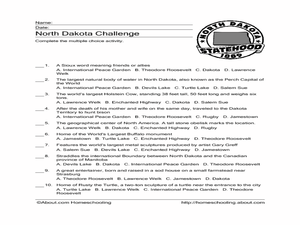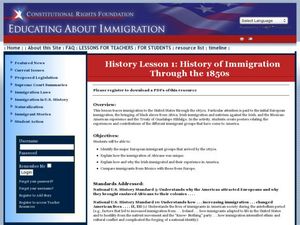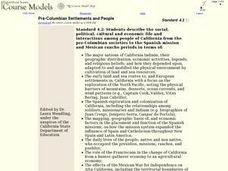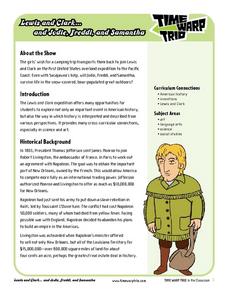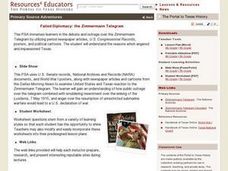Curated OER
Lesson: Looking Closer: The Artwork of Shinique Smith
A critical discussion regarding the nature of Shinique Smith's second-hand clothing art is the foundation for the lesson. Critical thinkers fully analyze the meaning behind her work, taking close consideration of where the clothing came...
National Endowment for the Humanities
Women's Lives Before the Civil War
Women's lifestyles before the Civil War made a huge impact as a point of causation. Give middle schoolers the opportunity to view firsthand the lives of women before the Civil War. They analyze primary source documents, view photographs,...
Curated OER
The Era of Good Feelings
Setting the context for the first part of the 19th century, the slides presented here display the "Era of Good Feelings," including the presidencies of Monroe and Adams. Maps and photographs help students to contextualize the concepts of...
K12 Reader
Broken Promises
This comprehension worksheet asks readers to respond to a series of questions based on an article about the treatment of native peoples.
Bismarck Public Schools
History & Math of the 1830s
Using this interdisciplinary worksheet, your young historians will have the opportunity to practice their math skills while learning about the drastic population increase in the United States during the presidency of Andrew Jackson....
Oklahoma State Department of Education
Narrative Prompt
Reading about history is nothing like experiencing it firsthand. Encourage your eighth graders to do the next best thing with a historical narrative prompt, in which they describe the experience of a first-time traveler on the...
Reed Novel Studies
Hatchet
A brief introductory presentation illustrates many images from Gary Paulsen's Hatchet. From berries to black bears, young readers take a quick trip through Alaska during a class reading unit.
State Bar of Texas
Dred Scott v. Sandford
Who decides someone is not a real person? Scholars investigate the Dred Scott v. Sandford court case which deals directly with slavery and citizenship. After viewing a short video clip, classmates work in pairs to assess and discuss the...
Curated OER
Taming Wild Land
Third graders consider the habitat needs of living things and how extensive farming in an area can affect the plants and animals of a region. They participate in a simulation to show how changing the habitat in one area can greatly...
Edgate
Discovering New Resources
What is a natural resource, and what resources did the Lewis and Clark expedition seek? After reading an article on the mapping of the west, learners get into small groups to discuss the important natural resources of the period. They...
Curated OER
Indians of the Pacific Northwest
Learners organize acquired information and make inferences as to the kind of habitat and its probable location. They identify and replicate art forms characteristic of the Pacific Northwest coast involving the use of ovoids and "u forms".
Curated OER
Go West With Lewis and Clark! Scavenger Hunt
In this Lewis and Clark scavenger hunt worksheet, learners participate in an Internet scavenger hunt to answer five questions regarding the Lewis and Clark expedition.
Curated OER
Perceiving the Prairie
Twelfth graders explore the changing concept of "prairie" through written and artistic works. They write their own poem or essay describing the prairie after discussing how differently people perceive the prairie.
Curated OER
North Dakota Vocabulary
In this North Dakota instructional activity, students match 14 words pertaining to the state of North Dakota with their definitions in another column.
Curated OER
North Dakota Challenge
In this North Dakota worksheet, students answer multiple choice questions about the history of North Dakota. Students answer 10 questions.
Curated OER
The War of 1812
A good addition to a unit on the War of 1812, this slideshow details causes, specific battles, political contexts, and several campaigns of the war. Maps and pictures with broad topics allow teachers to bring their own discussion topics...
Curated OER
Transcendentalism and Romanticism in American Literature
How do transcendentalists believe you must learn about the world? Use this PowerPoint to define transcendentalism and explain reason and intuition. Social, political, and philosophical influences of this time are introduced, and a few...
Curated OER
Pre-Colonial Native American Groups
Students investigate U.S. history by researching the Internet and taking a test. In this American Indian group lesson plan, students identify the many specific Native American tribes and their geographic locations. Students research the...
Curated OER
Yo-ho, Yo-ho a Viking's Life for Me
Students complete a unit of lessons on the Vikings. They analyze maps, read and discuss myths, summarize the main ideas from resource materials, watch videos, sing a song, draw a picture to illustrate Norse mythology, and define key...
Curated OER
History of Immigration through the 1850's
Learners research the history of Immigration. For this World History lesson, students explore European immigration then specifically focus on ways African Immigration was different. Learners then divide into small groups and create a...
Curated OER
Pre-Columbian Settlements and People
Fourth graders describe the social, political, cultural and economic life and interactions among the people of California from the pre-Columbian societies to the Spanish mission and Mexican rancho periods.
Curated OER
Lewis and clark...and Jodie, Freddi, and Samantha
Students practice descriptive language when one student describes an object to another student who cannot see it. They guess what the object is and relate the experience to that of the Lewis and Clark expeditionary journals.
Curated OER
Failed Diplomacy: The Zimmerman Telegram
Seventh graders continue their examination of World War I. In groups, they read a copy of the famous Zimmerman telegram and discuss its effect on Americans. To end the lesson, they discuss how public opinion changed after it became...
Curated OER
Flag Day Vocabulary Quiz
In this recognizing Flag Day terminology learning exercise, students match the vocabulary words with their definitions. Students match 15 answers.
















